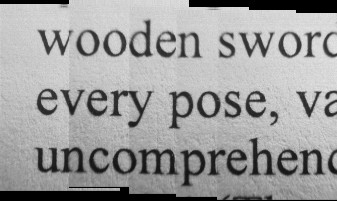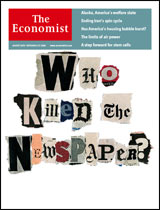It’s Alive!!!
August 31st, 2006 by Adam
But, no memory yet…
Publishers arn’t going to like this: Google now lets internet users download and print classic books for free. It’s going further than Project Gutenberg that has for some time been offering free texts. Google Books offers users attractively formatted copies from the original imprint. To find printable books, use the “Full view books” option in the search. They come in PDF format.
A Google Books search gives users a number of options including “search inside”, “buy this book”, “find this book in a library”, “search for reviews”, “search for related web pages”. Now it has added a “download” button to some books such as Bibliomania.
University libraries at Oxford, Harvard, Stanford, the University of Michigan and the University of California, are involved in the Google Books project. Publishers, however, are suing Google. Google’s defence is that although the public can search copyrighted texts online, they won’t be able to download and print them.
It’s not hard to imagine what Penguin Classics thinks about Google’s plans, but it would seem that there is not much the company could do to stop Google offering out-of-copyright works to the public. I can imagine calls coming soon from publishers to extend the length of the copyright term once again. This has already happened once after pressure from Disney to keep Micky Mouse under tabs. In most countries copyright lasts for 70 years after the death of the author.
It was discovered yesterday that the SDRAM chip doesn’t fit in those beautiful red circuit boards we had delivered last week.
Turns out there was a mistake during the design process where an incorrect template was used for the SDRAM chip.
This will probably set the Falstaff project back about one week. The hardware team is continuing to assemble the other components to make sure that the rest of the design looks good before we have the board rebuilt.
Ian MacDuff explained that the team has taken a risk by shortening some of the more typical review processes because of our rapid 10-week prototype schedule. We hope that things go well and that we can have working prototypes much sooner than normal. However, if mistakes are not caught immediately (as in this case), it can delay the project.
 Hi, This is Spencer Bliven. I’m a summer intern/part-time software engineer at Exbiblio. I thought I’d let you know about a part of Falstaff that I’ve been working on.
Hi, This is Spencer Bliven. I’m a summer intern/part-time software engineer at Exbiblio. I thought I’d let you know about a part of Falstaff that I’ve been working on.
As the first hardware comes together, we on the software side have been hurrying to make sure that drivers and applications are in place so that the hardware can actually do something when it is finished.
There are a number of steps to go from a scan on the pen to text on your screen. First, the data must be transfered to your computer over USB. This can either happen right when you scan, if the pen is connected, or it can happen later when you next connect the pen to the computer.
The scans work by taking a series of small images as you drag the pen across the paper.





This can be thought of as a video of what the pen sees, although it is at a very low frame rate. The next step towards extracting text is to stitch the small overlapping frames into one large image. We humorously call this process ‘storting,’ defined as the reverse of ‘distorting.’
David Warman has written a good program that takes the rotate, skewed, blotchy images we get from the pen and ‘storts’ them into a single image. The basic principle is the same as using Photoshop to stitch together several photos to form a panorama.

After a single image has been produced we perform OCR (Optical Character Recognition) to convert it into text. This text is finally sent to the Life Library application as a capture: every pose, v
By Spencer Bliven
 The Economist is asking “Who killed the Newspaper?” – and perhaps only a little prematurely.
The Economist is asking “Who killed the Newspaper?” – and perhaps only a little prematurely.
Unlike the book publishing industry, which seems to be doing fine for the moment, newspapers have undergone traumatic times as they’ve lost their share of the advertising market, down from 36% in 1995 to 30% in 2005 according to iMedia. It’s no mystery where the advertising revenues have gone: Google recently reported a 77% increase in earnings over the same period the previous year. Even worse, Craig’s List offers classifieds – a mainstay of newspaper revenues – for free – and few can compete with “free.” The biggest bright spot for newspapers is that visitor numbers to their online versions are growing fast.
In the UK, The Guardian has seen online revenues grow by about 50% a year, and its editor, Alan Rusbridger, has said he can see the time coming quite soon when they will outstrip print revenues. The Guardian even breaks news stories on the web, rather than holding onto them tightly for the morning edition. In response to the Economist’s gloomy story, Rusbridger said:
“I think the next few years are going to be very expensive for newspapers, there is no doubt there is a decline in circulation and there is a decline in advertising revenue because both are going to the web….
“They are also going to have to spend large sums of money investing in the web and new technology. I’m not convinced that everyone is going to make it.”
A big problem for newspapers is that online readers do not bring in the same revenues as commuters on the train. The Economist cites ratios ranging from 1 /10 to 1/100 for their comparative values. People tend to hop around the net, from one news-provider to another. There is also the danger that aggregators like Google News will grab revenues. Newspaper like the Guardian and The Telegraph have tried to tap the social media phenomenon with ambitious blog and podcast projects, giving readers full scope to participate and and therefore stay loyal to their sites.
Financial newspapers like the Wall Street Journal and the Financial Times have tried subscription models, which may work for specialist content – but most people have come to expect news for free: It’s just another commodity. Another response is to beef up the print editions with things that don’t work well online – like features and human interest, which can be more original and unique than news. My impression is that UK newspapers are well ahead of their US counterparts here, especially at the top end of the market – but still it’s not enough to stop the rot.
All this adds up to a big effort by newspapers to follow the money online. Many now see the web as their future. Exbiblio is running rather counter the trend with its ideas to help publishers make paper more attractive, both to the newspaper owners and to readers. It certainly sounds like an attractive proposition to have hyperlinks on printed paper – but it has to be remembered that click-throughs bring in pennies, not mega-bucks like display ads.
Brian Piquette (Synapse) and Ian MacDuff (Exbiblio) of our hardware team have provided the following photos of the bits and pieces of Falstaff coming together. Thanks guys!
This is the image sensor PCB. This PCB holds the CMOS sensor and the white illumination LEDs. It sits in the enclosure perpendicular to the long axis of the device, which points the sensor out the front of the unit.
The image below shows the sensor PCB with the milled plastic lens holder. The lens will screw into this plastic frame.
The PCB visible behind the Sensor PCB si the Main PCB. The Main PCB contains the processing core of the Falstaff unit. It has the ARM9 Processor, Flash and SDRAM.
The Button PCB (top) has the power supply, user interface (buttons and LEDs) and the interface between the sensor board and the main board.
Guy Kawasaki reflects on lessons learned as a member of the original Mac team and as a venture capitalist tired of listening to lame presentations in this entertaining video presentation.
I enjoy the teasing about MBAs and executive retreats as well as his perspective on keeping it simple and “making meaning” vs “making money”.
Check it out!
We’ve been using the name Falstaff to refer to our first prototype of the oPen. Falstaff will have three printed circuit boards (PCBs) to connect all of its electronic components: a processor board that has the processor, RAM, and ROM; an input/output board that has the buttons and lights; and an image-sensor board that, you guessed it, holds the image sensor and illumination lights.
Here’s a picture of Rev 1 of the Falstaff processor board which was completed on Wednesday. This board has eight layers of electrical connections through wires that are only 3 thousandths of an inch wide. The next step in the manufacturing process is to solder all the components onto this “bare” board.
The color of a circuit board comes from the outer layer which is called a “solder mask.” The solder mask covers all the wires to protect them, but leaves holes where the components are soldered to the board. Without solder mask, PBCs are a dirty-yellow color. For some reason, most circuit boards are made with green solder mask, but the manufacturers have many colors to choose from. Since future revisions of this board may look very similar, it is handy to make each revision of the board a different color so that it is easy to tell them apart.
By Ian MacDuff
Here’s an interesting thought:
Hyperwords™ allows you to interact with all the words on the web, not just links.
Sounds familiar? Exbiblio is making all text into potential hyperlinks. It goes about it in a different way from Hyperwords, but it’s interesting to see that others are thinking along the same lines.
Hyperwords comes as a free extension to the Firefox Browser. All you have to do is block some text on the webpage, and a menu presents you with a cornucopia of Web 2.0 options – Search, Email, Wikipedia, del.icio.us, Amazon, ebay, Google Maps, blog… All these and more are available with just one click. What’s very nice is that you can use it to copy and paste text and a URL all in one go.
Many thanks to Francisco, a regular visitor to this blog, for pointing this out. Here’s a short YouTube video about Hyperwords.